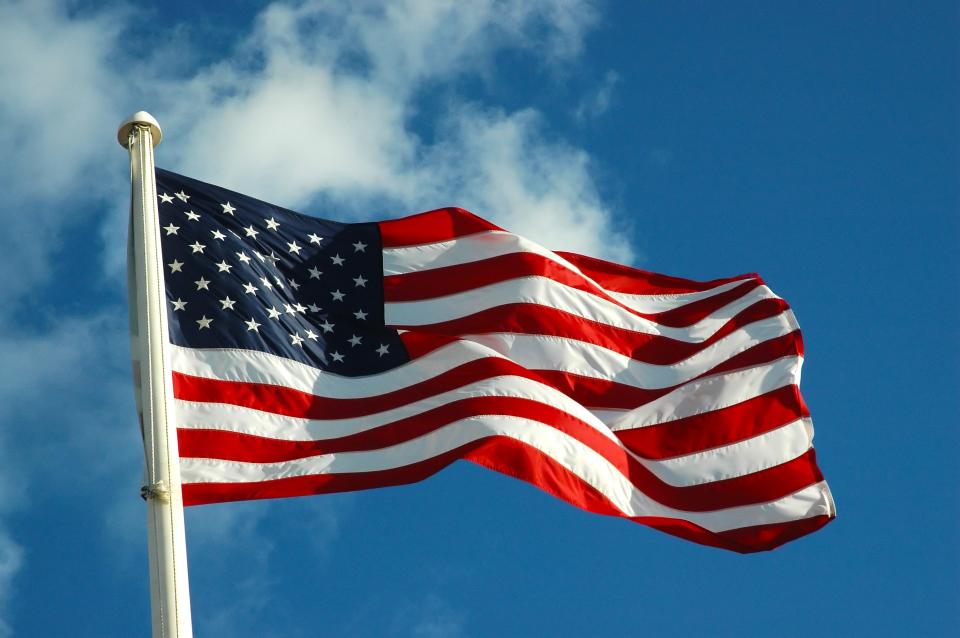Did Betsy Ross make the first one? Why is it nicknamed 'Old Glory'? What to know on Flag Day.
- Oops!Something went wrong.Please try again later.
Flag Day, observed annually on June 14, celebrates the day in 1777 when the United States approved the design for its first flag. While its look has changed more than a few times over the years, the American flag has remained a symbol of freedom and justice.
Some will mark Tuesday's holiday by displaying the red, white and blue at their homes and businesses. Others will celebrate with parades or at events sponsored by schools, veterans and groups like the National Flag Day Foundation, whose goal is to preserve Old Glory's history and pride.
Here are five fast facts about the flag and the annual holiday:
Who founded Flag Day?
Flag Day was founded by a school teacher named Bernard J. Cigrand, who began observing the day with his class at Stony Hill School in Wisconsin, according to Ozaukee County website.
In 1885, Cigrand urged his students to observe June 14 as “Flag Birthday.” He later wrote an essay published in a Chicago newspaper urging Americans to also celebrate the flag annually on that day.
President Woodrow Wilson issued a proclamation establishing the June 14 as Flag Day in May 1916. He said he hoped Americans would show "significant expression to our thoughtful love of America" each year.
Did Betsy Ross make the first flag?
Betsy Ross, the famed Philadelphia seamstress, is often credited for making the first flag. But there's no proof she did.
No official documentation has been found to confirm Ross was responsible for sewing the very first flag, according to History.com, but it is believed Col George Ross – a signer of the Declaration of Independence and her late husband's uncle – recommended her for the job.
If not Ross, who? Some historians say it was Francis Hopkinson, a New Jersey delegate to the Continental Congress and signer of the Declaration of Independence. He also played a role in designing seals for departments within the U.S. government.

What's the history of the U.S. flag?
On June 14, 1777, John Adams spoke about the flag at a meeting of the Continental Congress in Philadelphia: "Resolved, that the flag of the thirteen United States shall be thirteen stripes, alternate red and white; that the Union be thirteen stars, white on a blue field, representing a new constellation."
There have since been 27 official versions of the flag, according to the Library of Congress. The last change was made on July 4, 1960, when Hawaii became the 50th state.
The flag today features 13 horizontal red and white stripes, representing the nation's 13 original colonies, and a blue rectangle in the canton with 50 white, five-pointed stars representing the states.
What about the 'Old Glory' nickname?
The flag got its “Old Glory” nickname from William Driver, a Massachusetts-born resident of Nashville who hid his homemade flag from Confederate troops.
During the Civil War, Driver remained loyal to the Union and sewed “Old Glory” into a quilt for safekeeping, according to Tennessee Encyclopedia. When the Union army occupied Music City, Driver gave the flag to the troops to be flown for a short time over the State Capitol.
Driver is buried in the Nashville City Cemetery. “Old Glory” is exhibited at the Smithsonian Museum of American History in Washington, D.C.
Why red, white, and blue?
The Continental Congress left no record as to why it chose red, white and blue as the flag's colors.
But, in 1782, PBS reported, the Congress of the Articles of Confederation chose the colors for the Great Seal of the United States with these meanings:
White for purity and innocence.
Red for valor and hardiness.
Blue for vigilance, perseverance and justice.
Natalie Neysa Alund covers trending news for USA TODAY. Reach her at nalund@usatoday.com and follow her on Twitter @nataliealund.
This article originally appeared on USA TODAY: Flag Day: Here are 5 things you might not know about 'Old Glory'

